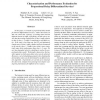Free Online Productivity Tools
i2Speak
i2Symbol
i2OCR
iTex2Img
iWeb2Print
iWeb2Shot
i2Type
iPdf2Split
iPdf2Merge
i2Bopomofo
i2Arabic
i2Style
i2Image
i2PDF
iLatex2Rtf
Sci2ools
98
Voted
ICNP
2000
IEEE
2000
IEEE
Characterization and Performance Evaluation for Proportional Delay Differentiated Services
In this paper, we consider a proportional delay model for Internet differentiated services. Under this model, an ISP can control the “spacing” of waiting times between different classes of traffic. Specifically, the ISP tries to ensure that the average waiting time of class ¡ traffic relative to that of class ¡£¢¥¤ traffic is consistently a specifiable ratio. If the ratio is less than one, the ISP can legitimately charge users of class ¡ traffic a higher tariff rate (compared to the rate for class ¡¦¢§¤ traffic), since class ¡ users consistently enjoy better performance than class ¡¨¢©¤ users. We use time-dependent priority scheduling to realize the proportional delay model. We formally characterize the feasible regions in which given delay ratios can be achieved. Moreover, a set of scheduling parameters for obtaining the desired delay ratios can be determined by an efficient control algorithm. Experiments are carried out to illustrate the short-term, med...
Related Content
| Added | 31 Jul 2010 |
| Updated | 31 Jul 2010 |
| Type | Conference |
| Year | 2000 |
| Where | ICNP |
| Authors | Matthew K. H. Leung, John C. S. Lui, David K. Y. Yau |
Comments (0)

